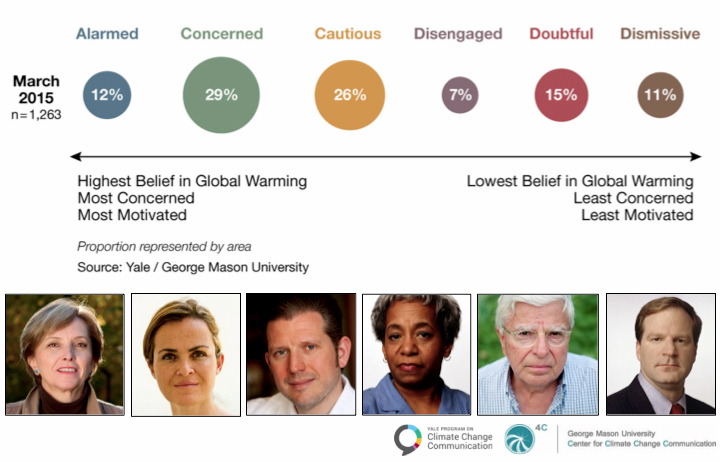You are here
Climate Change Characters
Think of the most negative and dismissive response to the question of whether climate change is happening. Some things that come to mind are probably yelling, denying, references to private property rights, and bashing left-leaning politicians. Now think of the most positive and affirmative response to the same question—dedication to reducing reliance on fossil fuels, references to scientific studies, and encouraging elected officials to take action now.
These two very different set of views on climate make up the ends of a spectrum of American beliefs on climate. The study Climate Change in the American Mind by Anthony Leiserowitz, Edward Maibach, and Andrew Light categorized this spectrum into Global Warming’s Six Americas. The participants were a nationally representative sample, and the six categories are an approximation of the beliefs of the U.S. adult population as whole.
The spectrum of the Six Americas measures belief, concern, and perceived need to take national action about global warming. Americans who are alarmed believe global warming is caused by humans and is a serious and imminent threat. At the other end, dismissive Americans doubt that global warming is happening, that it’s caused by human activities, and that global warming is a real threat.
The largest segment, the concerned, perceives global warming as a human-caused threat that does require a national response. They also report the desire to engage in consumer action to help combat global warming. However, individuals in this category take fewer actions and are less personally involved than the alarmed.
My Summer Research Project
From the beginning of my project, the Six Americas has been essential background information. I was first introduced to the concept by one of my mentors, Dave Kittredge. According to him, the Six Americas is one of the first attempts at categorizing beliefs and attitudes that Americans have toward climate change. Therefore, the Six Americas is groundbreaking for understanding views on climate change.
So far, our project has consisted of distributing our PING study online to people who own woodland in New England. The PING study involves a preliminary survey, four weeks of a single question survey each week, and a final survey. For more information about this study, please read Kate Rawson’s blog here.
The second part of our project involves interviewing landowners that own land near the Green Mountain National Forest. The PING study has given us a few interesting interactions with talking with people over email or over the phone. Soon, the interviews we will be conducting will be full of interesting interactions with all kinds of people.
It is in these interviews that I expect to encounter the Six Americas, the six categories of belief and concern about climate change. Thinking on the Six Americas, I have created my own cartoon representations of these different categories of people. Keep in mind that my own biases may come into play in these cartoons; however, I think many of us could easily picture the six categories being represented as I depict.



